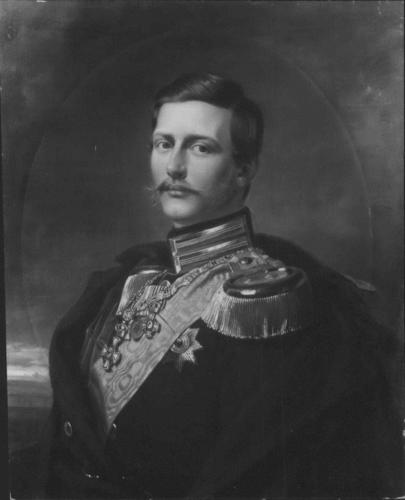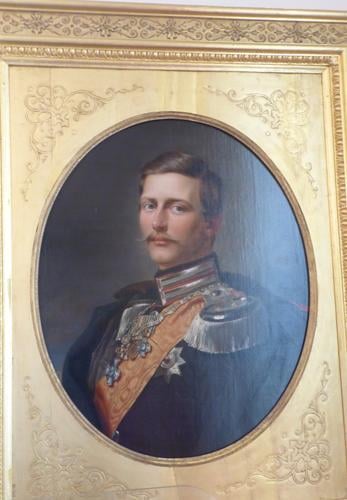Prince Frederick William of Prussia (1831-1888), later Emperor Frederick III of Germany 1857
Oil on canvas | 80.5 x 65.5 cm (support, canvas/panel/stretcher external) | RCIN 405122
-
Franz Krüger (1797-1857) trained under the printmaker Carl Wilhelm Kolbe. He was given a place at the Academy in Berlin in 1812, although he continued to train independently. Among other subjects his hunting and stable scenes found favour in Prussian society. The Napoleonic wars inspired him to paint military subjects, and he achieved success with works such as March of the Prussian Cavalry (1820; Doorn, Huis Doorn). His portrait of Prince August of Prussia (c. 1819; Doorn, Huis Doorn) won him access to the patronage of the court. In the representation of historical events Krüger was able to successfully combine portraits and genre painting; this talent is shown in his painting of the Large Parade on the Opernplatz, commissioned by Tsar Nicholas I of Russia (1830; Berlin). In addition to the respect he had gained at the Prussian court, he was esteemed as a portrait painter in the courts of Hannover, Schwerin, and in St Petersburg, where he spent the years 1836, 1845, 1847 and 1850–51.
Prince Frederick William of Prussia (1831-88), known affectionately as ‘Fritz’, was the only son of William I, King of Prussia, Emperor of Germany, and Augusta, daughter of Charles Frederick, Grand Duke of Saxe-Weimar-Eisenach. In 1858 he married Victoria, Princess Royal, the eldest daughter of Queen Victoria and Prince Albert. Though a victorious commander in the Prussian War (1870 – 71), his liberal sympathies made his position at court in the following years difficult. He succeeded his father as Emperor in 1888, but ruled for only 98 days, before succumbing to throat cancer.
The Prince appears here wearing the uniform of a general in the Prussian army, with the ribbon and star of the Order of the Black Eagle, and the collar and badge of the Hohenzollern House Order. It was painted after Prince Frederick William had become betrothed in marriage to Victoria, Princess Royal. Queen Victoria expressed her reservations about the match to her uncle, Leopold I, King of the Belgians: ‘I cannot say that I feel quite happy about this selfsame marriage; she is so young – he – excellent & adoring her – but very young of his age’ (RA VIC/Y 102/7). By the end of 1857, Queen Victoria reassured her uncle: ‘Fritz I find decidedly improved & very amiable & good’ (RA VIC/Y 102/39, 24 November 1857).
Among the many royal portraits, and works after portraits, by Krüger in the Royal Collecttion, is a miniature copy of this portrait, painted on ivory by Hermann Hanstein (RCIN 420540).Provenance
Painted for Queen Victoria, September 1857; recorded in the 1855 Room at Buckingham Palace in 1876
-
Creator(s)
Acquirer(s)
-
Medium and techniques
Oil on canvas
Measurements
80.5 x 65.5 cm (support, canvas/panel/stretcher external)
Alternative title(s)
Emperor Frederick III of Germany (1831-1888), when Prince Frederick William of Prussia.









